Green peafowls are one of the three species of peafowls in existence; of the three, they are the largest.
They share many features with Indian peafowl (the species most peafowl owners have). Still, there are many differences between them.
Green peafowls also go by Javanese Green peafowls, Javanese peafowls, Java Greens, or Indonesian peafowl. As you may have guessed, these names indicate that green peafowls have some links with the island of Java in Indonesia.
Below, we have compiled a green peafowl breed profile. So, if you want to keep some green peafowls or have questions about them, you will find the information in this article very helpful.
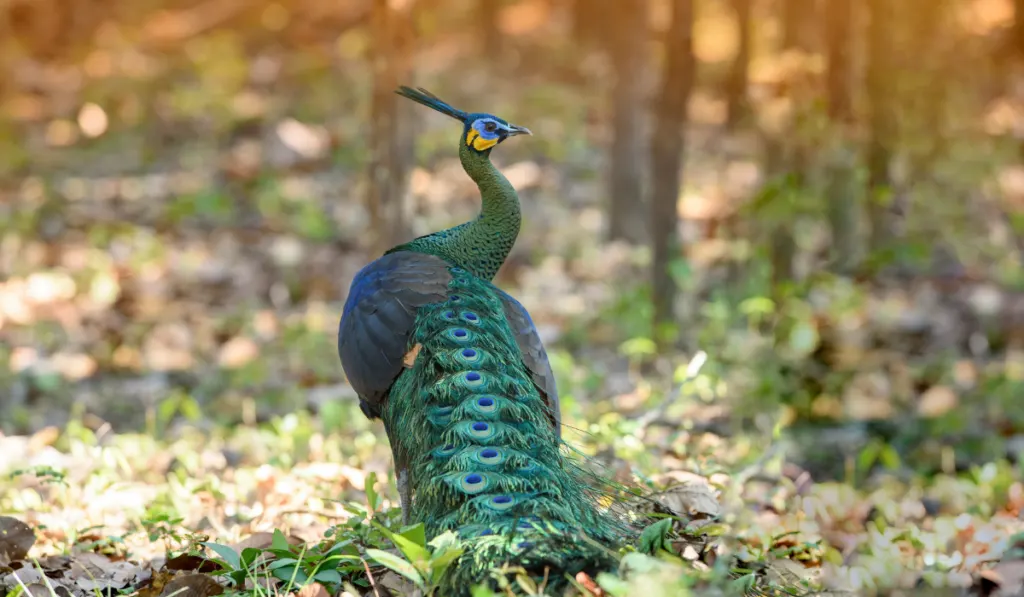
Table of Contents
History
The green peafowl is a peafowl breed native to Indonesia; hence, people call it the Indonesian peafowl.
You are more likely to find green peafowl on the island of Java and in Myanmar. But besides these two places, you may find them in Cambodia, Thailand, China, Vietnam, Laos (Lao People’s Democratic Republic), and other parts of Indonesia.
In the past, it was widespread across Southeast Asia. But in recent times, the range of this large peafowl breed has become limited.
The reduction in the range of green peafowl stems from habitat loss and poaching.
Of course, you can still find green peafowl across Southeast Asia, but their population has declined markedly. As such, you may not see them in some places they used to be.
The reduced range of the green peafowl has caused a significant population decline in the breed.
Unsurprisingly, green peafowls are currently in the endangered class of the IUCN (International Union for Conservation of Nature) Red List.
Besides habitat loss and hunting, hybridization is another threat to the existence of green peafowl. But unlike those two factors, hybridization is a minor issue because it does not alter the species too much.
That being said, there are many subspecies of green peafowls. So, if you want a pure green peafowl, be sure you are getting the right breed.
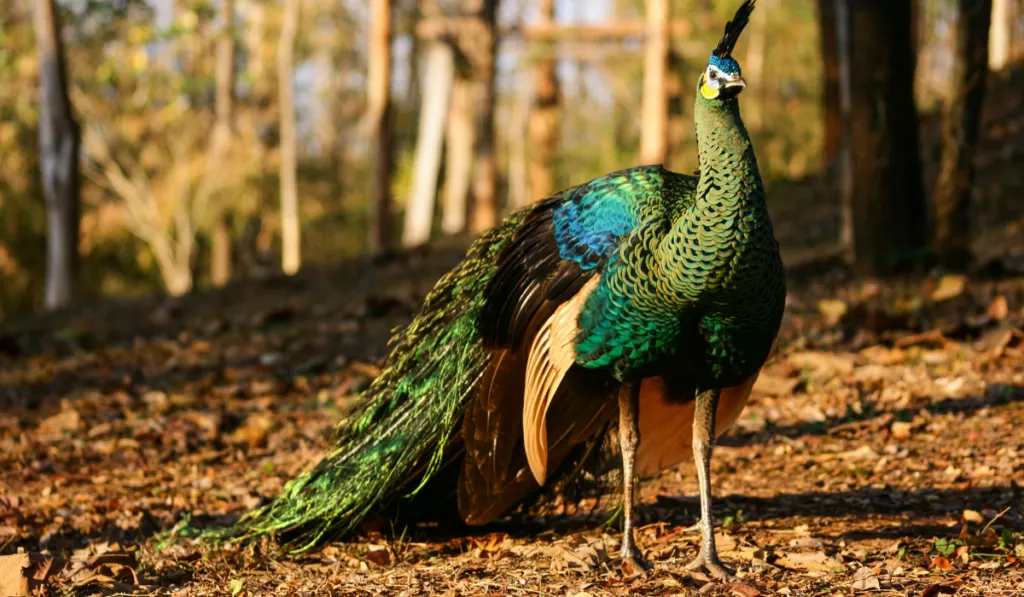
Population
The population of green peafowls is around 15,000 to 30,000, of which 10,000 to 20,000 are adult birds. As said earlier, the breed is endangered.
Habitat
Green peafowls are primarily tropical or subtropical birds. You will find them in various biomes, including shrublands, forests, savannas, and farmlands.
While the habitat of green peafowl varies from place to place, they generally prefer areas close to a water source and far from people.
More often than not, green peafowls stay on or close to the ground. But at night, they can roost in trees as high as 33 feet to 50 feet.
Characteristics
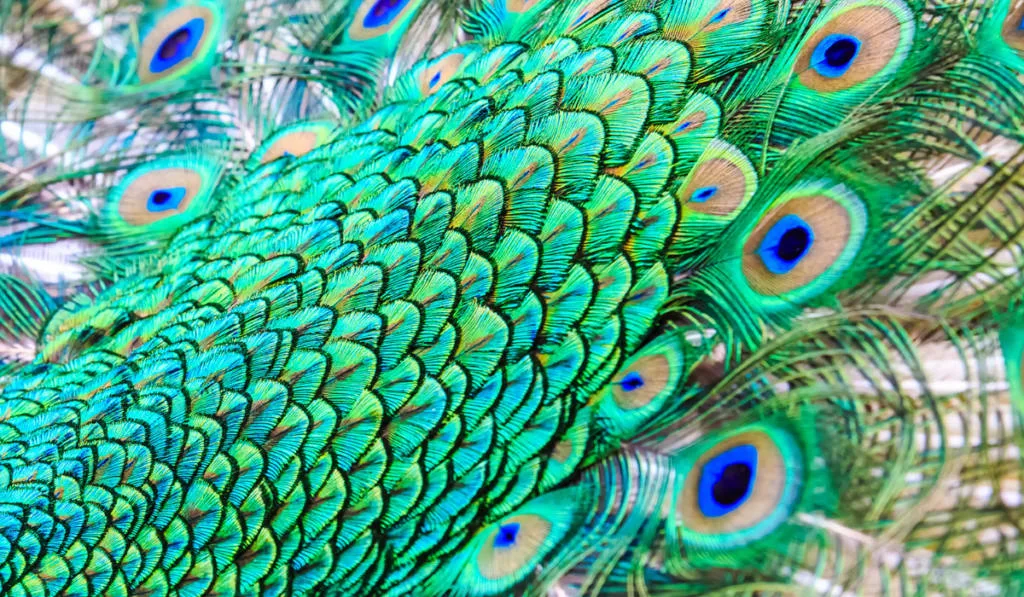
Size
As said before, green peafowls are the largest peafowl species. They are 39 inches to 118 inches long, and their wings extend up to 47 inches to 63 inches.
On average, green peafowls weigh 8.4 pounds to 11 pounds. Green peahens are generally smaller than green peacocks, partly because they do not have a train of tail feathers.
Flight
They might be the largest peafowl species, but green peafowl can fly. They can hit a top speed of up to 10 miles per hour (mph) when in flight.
Appearance
As their name implies, green peafowls have a green, iridescent, scale-like plumage. Alongside the green feathers, their wings have some blue coloration. The blue coloration is more common in males than females.
Green peafowls have multiple colors on their face. They have two stripes of light blue around their eyes. Then they have a patch of orange below that.
Between their eyes and beak is a dark triangle. In peacocks, this triangle is blue-green, but in peahens, it is brown.
Green peahens also have some copper-colored neck scales, but peacocks don’t.
Overall, green peacocks look green and bronze. The peahens, on the other hand, look green and brown.
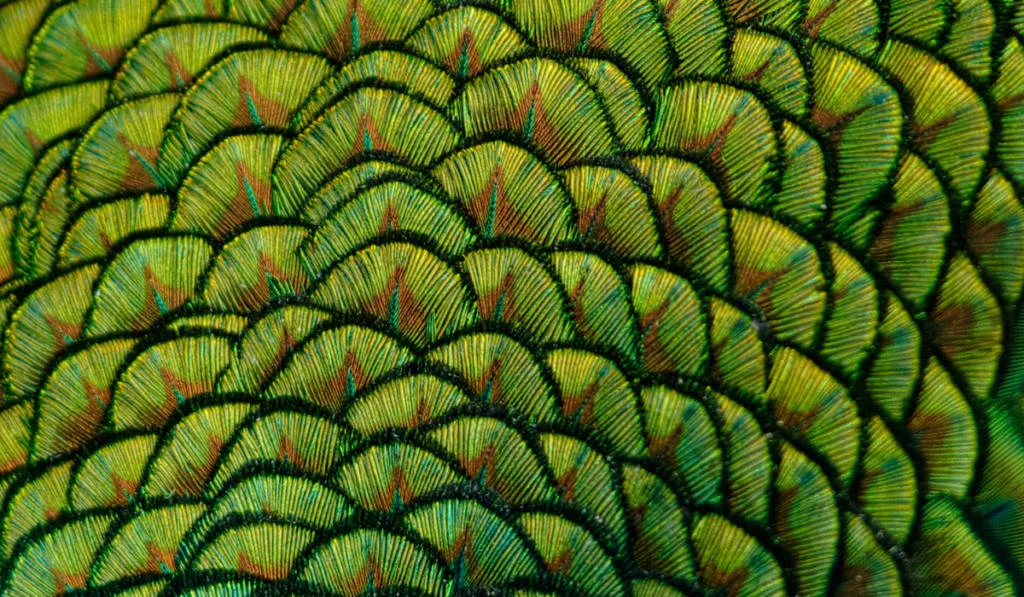
Green peacocks have a train of tail feathers, which the peahens do not have.
The feather train comes primarily from the elongated upper-tail covert of the birds. Of course, as is typical of peafowls, the trains of green peacocks have an iridescent eyespot within bronze and blue rings.
Calls
Even though green peafowls can be noisy, they are generally noiseless outside breeding season. At least compared to Indian peafowls, green peafowls make less noise.
The call of green peafowls has a lower pitch than Indian peafowls.
When green peacocks call, they make a loud, repeated sound. Their call sounds like “kee-wow” and can be pretty irritating. So, if you want a green peafowl, ask yourself if you can tolerate the noise.
When green peahens call, they make a loud, repeated honking sound.
Peahens typically make the honking sound when flustered. But sometimes, they do so as a mating response. Overall, female green peacocks do not call as often as the males.
Sometimes, green peacocks make the same honking sound as the peahens when flustered.
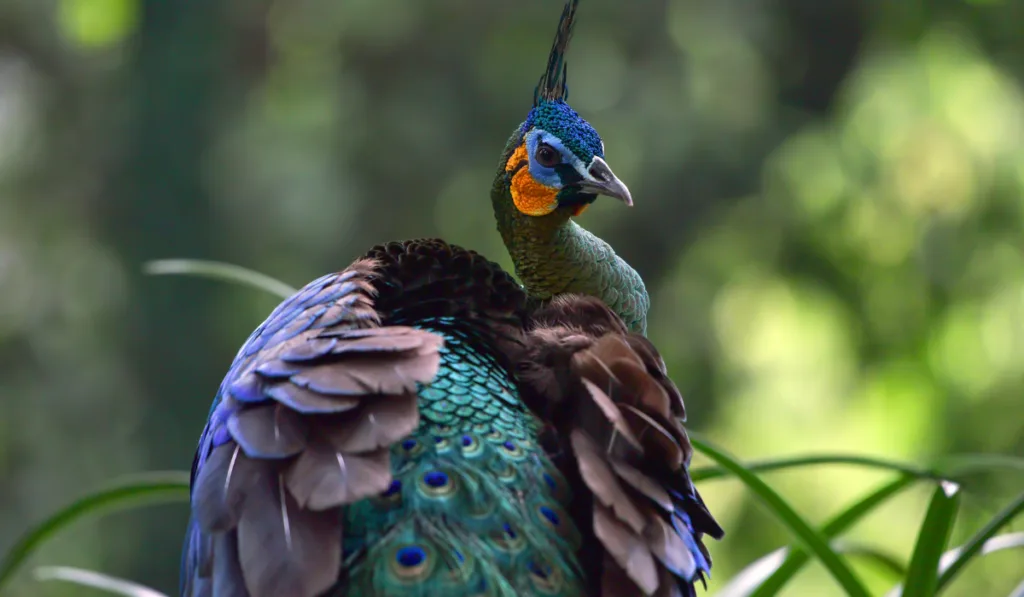
Lifespan
Green peafowls live around 12 to 15 years. But then, reports show that some can live as long as 50 years.
Reproduction
Outside the breeding season, male green peacocks molt. They regrow those feathers just in time for the breeding season.
The breeding season of green peacocks runs from April to June. It may extend until July; the season’s length depends on natural incubation and feather-train molting.
Peacocks that molt their feather train earlier have a shorter breeding season than those that molt later.
Also, if you remove eggs from beneath the peahens and incubate them artificially, they will keep laying throughout the season.
When trying to court a peahen, green peacocks flicker their train feathers. While flickering, the train feathers make a unique sound. These acts are a part of the courtship display of green peacocks, indicating fitness.
In the wild, green peacocks are polygynous: one male breeds multiple females. But in captivity, they are monogamous.
Male green peafowls are typically solitary and territorial in the wild. So, finding one male in a group of many peahens is not uncommon.
Green peacocks are typically aggressive during the breeding season. So, if you intend to keep one, do not keep it with other birds.
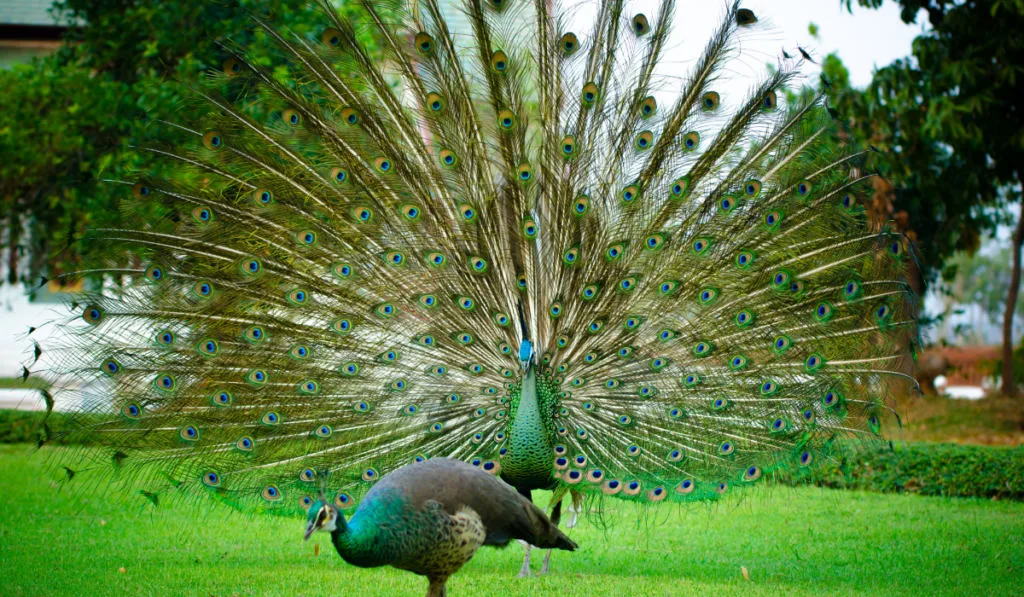
Egg Laying
Green peahens lay three to eight large eggs per clutch.
They incubate the eggs on the ground by themselves in protected areas. Then after 26 to 28 days, the eggs hatch.
Peachicks are interesting because they come out precocial (eyes open), and their wings have feathers. So, within two weeks, peachicks can start flying.
Green peafowl eggs are about three times the size of a chicken egg. However, the tastes of both eggs are not so different.
If you are raising green peafowls, you can almost tell when it is time for your peahens to lay eggs. You will notice your peahen pacing around with limp wings while making a repeated squawking noise.
These signs show up in the afternoon. Peahens generally lay their eggs in the evening.
Still, something could be wrong if the peahen does not lay the eggs within 24 hours after showing those signs. For instance, the peahen may be egg-bound.
If you suspect your peahen is egg-bound, get to a vet. Egg binding can become life-threatening if not handled quickly and correctly.
You can reduce the likelihood of egg binding in your birds by giving them just enough calcium supplements.
Uses
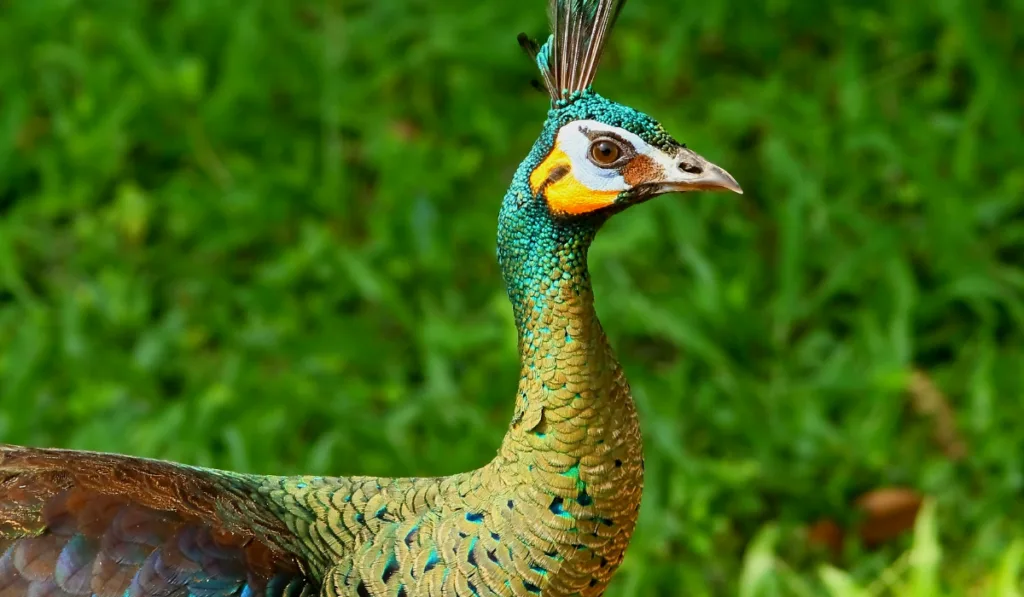
Due to their endangered status, green peafowls are typically used for ornamental purposes only.
Some people may still raise them for meat and eggs. But in some places, raising them for such purposes might be illegal.
Temperament
Compared to Indian peafowls, green peafowls are more aggressive. The males sometimes attack humans, especially when it is breeding season.
Seasonal Behavior
Green peacocks are not migratory.
Hatching and Raising
Feeding
Green peacocks are omnivores. So, they feed on all kinds of things in the wild, from seeds to insects, fruits, rodents, amphibians, and small reptiles.
Green peacocks have long train feathers. Understandably, they need protein for healthy growth.
Therefore, you should give your green peafowls high-protein game bird feed in captivity. You should also add vegetables, fruits, and seeds as supplements to the diet. This will raise the overall nutrient profile of their meals.
For extra protein, supplement the game bird feed with cat or dog feed. This additional protein supplementation is helpful when the peacocks are regrowing their feathers after molting.
Housing
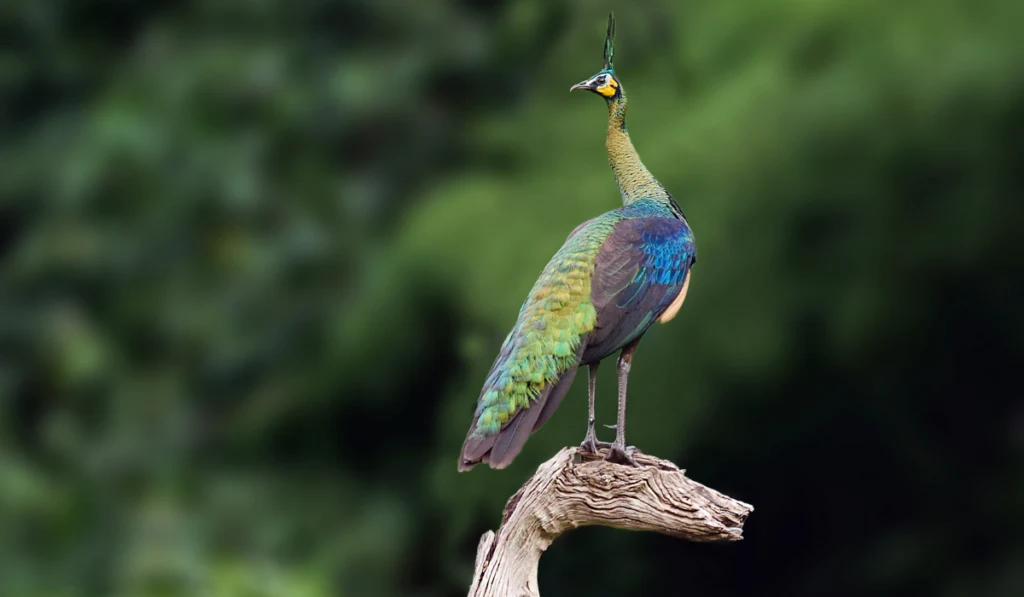
Green peafowls are aggressive. So, you should avoid housing them with birds of other species.
Besides their aggression, green peafowls are susceptible to blackhead disease and coccidiosis, which chickens carry. So, keep them away from chickens.
The ideal housing for green peafowl in captivity is a large coop with a lot of space. Green peafowls are large-sized birds, so they wouldn’t be able to act naturally with minimal area.
Green peafowls are tropical birds. So, when winter comes, you must keep them warm.
You should try to keep them in a space with a temperature of at least 50°F. Their usual housing may not be enough in winter. So, ensure you prepare adequately.
Resources
- https://www.bluecreekaviaries.com/peafowl#
- https://animalia.bio/green-peafowl
- https://www.britannica.com/animal/peacock
- https://www.fauna-flora.org/news/unlikely-story-green-peafowl/
- https://petkeen.com/green-peafowl/
- https://kidadl.com/animal-facts/green-peafowl-facts
- https://northernnester.com/peacock-noise/
- https://eartharchives.org/articles/all-the-right-moves-the-physics-of-a-peacock-s-mating-dance/index.html
